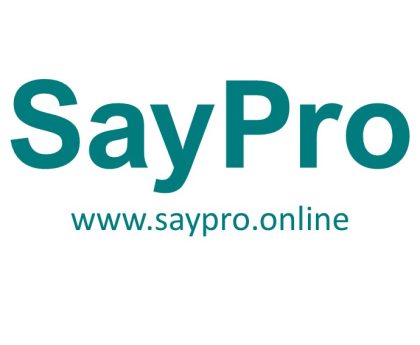SayPro Supplier Lead Time Target: Achieve an average supplier lead time of 5 days or less from SayPro Monthly April SCMR-17 SayPro Monthly Inventory Management: Stock tracking, order fulfilment, and supplier management by SayPro Online Marketplace Office under SayPro Marketing Royalty SCMR
Overview
Supplier lead time—the duration between placing an order with a supplier and receiving the goods—is a critical metric that directly impacts SayPro’s inventory availability and overall supply chain efficiency. The target for Q2 and onward is to achieve an average supplier lead time of 5 days or less to ensure that products are replenished promptly, avoiding stockouts and delays in order fulfillment.
Importance of the Target
- Inventory Optimization: Shorter supplier lead times enable leaner inventory levels, reducing holding costs while maintaining adequate stock.
- Order Fulfillment: Timely supplier deliveries prevent delays in customer order fulfillment, supporting SayPro’s commitment to a 98% on-time delivery rate.
- Supply Chain Agility: Faster lead times allow SayPro to respond quickly to market demand fluctuations and seasonal spikes.
- Cost Efficiency: Minimizes emergency purchases or expedited shipping costs caused by late deliveries.
- Supplier Performance: Establishing this target encourages strong supplier partnerships and accountability.
Detailed Target Explanation
- Measurement:
Supplier lead time is measured as the number of calendar days from the date the purchase order is placed to the date goods are physically received and verified at SayPro’s warehouse or fulfillment center. - Calculation: Average Supplier Lead Time=∑Lead Times of All Orders in PeriodTotal Number of Orders Received\text{Average Supplier Lead Time} = \frac{\sum \text{Lead Times of All Orders in Period}}{\text{Total Number of Orders Received}}Average Supplier Lead Time=Total Number of Orders Received∑Lead Times of All Orders in Period
- The goal is to have this average at 5 days or less, evaluated on a rolling monthly or quarterly basis.
Strategies to Achieve the Target
1. Supplier Performance Management
- Regularly assess suppliers on their delivery timeliness, accuracy, and responsiveness.
- Use data-driven scorecards to monitor supplier lead times and identify consistently high-performing vendors.
2. Negotiation and Contracting
- Negotiate favorable terms that include lead time commitments and penalties for late deliveries.
- Establish clear expectations and service level agreements (SLAs) with all key suppliers.
3. Forecasting and Order Planning
- Share demand forecasts with suppliers to help them plan production and logistics effectively.
- Place orders proactively based on predictive analytics and historical sales data.
4. Streamlined Procurement Processes
- Simplify internal purchase order approvals and communication channels to reduce order processing delays.
- Adopt electronic data interchange (EDI) or automated ordering systems for faster order transmission.
5. Strategic Supplier Partnerships
- Develop close relationships with suppliers to foster collaboration and problem-solving.
- Explore opportunities for vendor-managed inventory (VMI) or just-in-time (JIT) delivery models.
6. Risk Management and Alternative Suppliers
- Identify backup suppliers for critical products to mitigate risks of supplier delays.
- Conduct periodic reviews to ensure supply chain resilience.
Monitoring and Reporting
- Use SayPro’s inventory and supplier management tools to track lead times on all incoming orders.
- Generate weekly and monthly reports highlighting average lead times, deviations, and trends.
- Set up real-time alerts for orders approaching or exceeding the 5-day threshold.
Expected Outcomes
- Improved inventory turnover and reduced stock holding costs.
- Higher order fulfillment rates due to consistent inventory availability.
- Stronger supplier relationships and improved communication.
- Enhanced ability to react to market changes with agility and confidence.
Conclusion
Achieving an average supplier lead time of 5 days or less is a key strategic goal for SayPro’s Online Marketplace Office. By focusing on supplier performance, procurement efficiency, and proactive planning, SayPro will optimize its inventory replenishment process, ensuring that customers receive their orders promptly while minimizing costs and operational risks.

